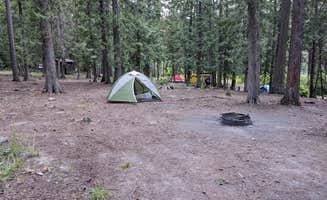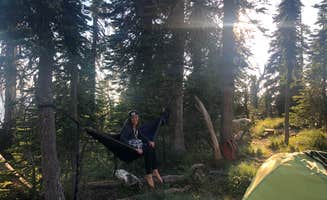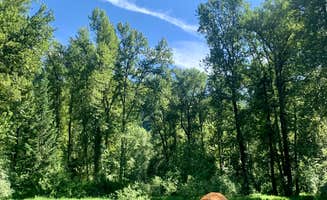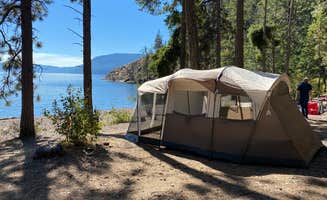Tent camping near Trout Creek, Montana offers remote wilderness experiences in the heart of the Cabinet Mountains. The region sits at elevations between 2,400 and 7,000 feet, creating diverse camping zones from riverside flats to alpine lake settings. Summer temperatures typically range from 45°F at night to 85°F during peak days, with frequent afternoon thunderstorms in July and August.
What to do
Fishing local waters: Lake Elsie Campground provides excellent fishing opportunities with both rainbow and brook trout. According to Jessica C., "We always catch lots of brooke and rainbow trout and wild life is everywhere! There is an outhouse bathroom but you are on you're own otherwise!"
Mountain biking trails: Areas near Breakwater Campground connect to extensive trail networks. As one camper notes, "It's a great starting point to some really good dirt bike trails. Be prepared for no cell service. 0 amenities. it's just a place to pitch a tent and have a fire. And it cost nothing."
Peak hiking: For experienced hikers, Scotchmans Peak offers challenging terrain with significant rewards. "This is a very very difficult hike, which makes camping here even more rewarding. Plenty of wildlife. I have only been one time and not seen mountain goats," reports Shariah T.
Kayaking and paddleboarding: The clear waters at Lake Elsie are perfect for small watercraft. Nathan M. shares that it's an "Awesome lake for kayaking and paddle boarding," though access requires navigating "primitive" roads.
What campers like
Secluded camping spots: The region's more remote sites offer exceptional privacy. At Lake Creek Campground, Darrin L. found that "I stayed in the dispersed area for 4 nights and really enjoyed the seclusion here. The campsite is about 6.5 miles off the highway which feels pretty far once you get there."
Waterfront access: Many tent sites in the area offer direct lake or river access. Lane P. notes that Breakwater Campground "stretches along a tributary of the CdA river, and there is great tent camping and fly fishing. Downside is that there is limited vehicle access to most spots."
Wildlife viewing opportunities: The Cabinet Mountains area is rich with wildlife sightings. At Lake Elsie, campers should "Be careful with your food and be smart," as Natalie J. reports, "multiple bears went through the campground in the evening and came back at around 3am."
Off-grid experiences: Many sites have no cell service, creating true disconnection opportunities. Saphrenne R. says of Lake Elsie, "There is a beautiful alpine lake, which is obviously cold spring water. But, you can get away with taking a dip in the summer season! There is really good fishing and ATV trails for MILES through the wilderness!"
What you should know
Fire restrictions: Summer fire bans are common, particularly from July through September. At Lake Elsie, Diadra G. observed that "Despite being stage 1 fire restrictions, multiple people were having fires, one person's was still smoldering when I got up the next morning."
Road conditions: Many access roads to remote camping areas are unmaintained. At Green Bay Campground (currently closed for 2024), Emily S. shared her "Biggest complaint - road to get there. You do have to walk to your site but it's not far. Views are magical."
Bear safety requirements: Bears are active throughout the region, requiring proper food storage. Alex P. notes that at Lake Creek Campground, "3 of the 4 sites had bear boxes, it was only site 2 that appeared to not have one."
Toilet facilities: Most sites have vault toilets with varying maintenance. Darrin L. found at Lake Creek that "Bathrooms were ok, about as clean as you would expect a campground bathroom to be."
Tips for camping with families
Choose established campgrounds: Families tend to have better experiences at sites with basic amenities. At Gold Rush Campground, Christopher R. found a "great little camp in canyon bottom" with a "great trail for hiking and exploring. This camp is not heavily used so you could possibly get the place to yourself."
Pack for changing weather: Mountain weather can shift quickly, even in summer. William N. recommends timing your visit carefully at Green Bay: "We arrived on a Wednesday and had the place nearly to our selves. This was a perfect place to camp with a family or with friends."
Arrive early for prime sites: Most campgrounds fill quickly during summer weekends. At Lake Elsie, Russell M. found it to be a "Sure a neat little fun place. Roughly 11 miles from where the asphalt ends is this little hidden gem."
Watch for wildlife encounters: Teach children proper wildlife safety protocols. Celine K. warns about Scotchmans Peak: "Be sure to read trail reports and weather reports before heading out. North Idaho weather can be pretty finicky, especially at high elevations. Make sure to be aware of wildlife as well!"
Tips from RVers
Site limitations: Most remote sites near Trout Creek have size restrictions for vehicles. At Copper King Campground, Matthew S. reports, "This campground doesn't really accommodate large RVs, but it's great for tent camping. There are five sites with generous spacing."
Limited hookups: Most campgrounds in the area have no electric or water connections. Matthew S. adds that at Copper King, "Each site has a picnic table and a fire ring. There is a privy and one bear box in the middle of the circle."
Access considerations: Many roads to camping areas aren't suitable for RVs. For Lake Elsie, lili G. cautions that the "ROAD IS NARROW, WINDY, AND STEEP. not at all trailer or big rig friendly. The site is free, and there are 11 first come first serve sites."






